This is a very long Marmotte report. For those not interested in cycling it may be extraordinarily dull indeed. For those who are considering riding the Marmotte or who rode the 2014 Marmotte it may still be pretty dull - but it may trigger a few moments of recogition, or be of use in planning your ride...
Prologue
I don't know for sure when I first heard about the Marmotte but I suspect it must have been in 2011 when I was training for the Modane to Alpe d'Huez Etape du Tour. That Etape took in the Telegraphe, Galibier and Alpe d'Huez climbs that make up the last two thirds of the Marmotte and I remember on some of the cycling forums people were saying that it was a relative stroll in the park.
Anyway, the name stuck in my mind and as I got more and more into sportives it became clear that the Marmotte, along with the Maratona del Dolomites, was one of those events that serious cyclists considered a 'must do' and which people spoke about with a mixture of fear, admiration and excitement.
So, when I noticed on one of the bike forums that entries for the Marmotte were about to go on sale, I registered. It didn't mean I absolutely had to ride it but at least I had the option (although it would be a bit rude not to exercise that option).
A couple of weeks later I was out drinking with an old university friend, Dan, who has never done any serious cycling apart from commuting to work in London and I persuaded him that the Marmotte was something he should attempt. In nine months time. He foolishly agreed. And when I talked to him a couple of weeks later he said he was already in training, had bought a turbo and was regularly doing laps of Richmond Park. Uh oh, if Dan's actually taken up the challenge properly then I better get training too.
The training
I think I'd better write a separate article about my training regime for the Marmotte, otherwise this is going to develop from a novella into War and Peace (without the humour or brevity). Let's just say that running a business and having a wife and young children is not the best recipe for a Marmotte training programme, especially if you're not someone with an established base of fitness. My wife and family deserve a lot of thanks for having put up with my time away on a bike while I got myself ready for the Marmotte.
One advantage of running my own business is that I am able to take Wednesday mornings off to do long rides (80km to 120km), mainly with the Rapha Cycling Club. I also rode on Sunday mornings, trying to get back around midday to then spend some time with the family. My wife would say that I spent a lot of time training and had focussed on nothing else, I would say that I got in what I could at around eight hours per week for the last 10 weeks before the Marmotte; and most of the people I cycle with would say that I probably hadn't put in the necessary hours to make it a total success. Don't these people have jobs? Or families? Well, I guess cycling is a better addiction than cocaine or alcohol.
Ten days before the Marmotte I went out on a training ride from London to Brighton and back and I felt pretty strong and happy with my fitness. In my training rides up the infamous Swain's Lane in Highgate, north London, I was recording times 23% faster than when I had ridden the Etape in 2011. I could do this.
Getting there
Dan and I had decided that driving to the Marmotte was better than flying. Once you've factored in the transfers and the faff of rebuilding your bike after you've dismembered it in a bike box (unless you actually know what you're doing, which I don't) then I am not convinced flying is much quicker. And besides, who can resist a road trip?
I'll deal with more details about driving to the Marmotte in a separate article but it was a pretty smooth journey until we got to Bourg d'Oisans. We stopped at the Casino supermarket for provisions and then I suggested to Dan that I drive up to our apartment in Alpe d'Huez so he could check out the famous 21 bends more easily. As we drove up the Alpe I could see Dan's face draining of colour as he realised that just three days later he would be tackling this insane climb, only not in a car and with 160km of serious riding already in his legs. He didn't cry but his conversation definitely dried up.
We arrived in Alpe d'Huez and spent half an hour searching for the letting agency who had the keys to our apartment, before driving to the apartment and discovering that we had booked somewhere that charitably could be described as cosy and even an average London estate agent would have struggled to get further than minuscule in their particulars. Dan took the sofa bed in the living room and I took the bunk bed in the corridor to the bathroom and loo. Good thing Dan had thought we might want to bring some sheets and towels as there were none supplied. I guess at 260 euros for four nights in a ski resort we should have guessed it would be one star accommodation.
Registration and preparation
We arrived around 6pm on Wednesday night to allow ourselves plenty of time to acclimatise and rest ahead of the Marmotte. We had been told by friends who had ridden it before that this was the time to ensure we tapered properly and that on no account should we attempt to ride up Alpe d'Huez. This was hard to resist as we both live in London and don't have Alpine mountains on our doorstep most of the time. But resist we did.
On Wednesday night we had a pizza and a bottle of wine and planned for a quiet day on Thursday with plenty of sleep. Of course, both being parents of young children, we both woke early and after a brief stroll around the village to get baguettes and pastries I caught up with work while Dan read about the political machinations of the start of World War I.
Then we decided to spin our legs by riding up to a restaurant slightly above Alpe d'Huez which the tourist information has recommended to us. Unfortunately it turns out that the first week of July is not really the time to explore Alpe d'Huez's tourist delights. With French schools only ending on the Friday before the Marmotte, pretty much every tourist attraction only opens on the Saturday. So our leisurely spin up to the lake restaurant above the village was not a great success as the owners and chef sat there in the sunshine eating their lunch and telling us that they were still closed. We dropped back down to the edge of the village and had lunch in a distinctly average but hugely overpriced restaurant whose interpretation of a Caesar salad left us puzzled.
We returned to the phonebox sized apartment to drop off our bikes and then we wandered up to the Palais du Sport to register for the Marmotte. 4.30pm on Thursday is probably the peak team you can register for the Marmotte (for example, there was no queue at 5pm on Friday) and we found ourselves in a line of about 150 people. One thing that you swiftly realise about the Marmotte is that there are enormous numbers of Scandis/Nordics and that most of them seem to be Danish. Everywhere I looked there seem to be shaven headed (and legged), massively educated Alpha males from Copenhagen looking intimidatingly fit. I later found out the 2100 of the 7500 riders in this year's Marmotte were Danish, so what I thought was paranoia was actually just reality.
Registration was simple for most people. If you know your allocated start number, which is available in advance on the Internet, then you go over to the section of the room indicated (roughly in two thousand entry increments) and they dig out your timing chip and race number to put on the front of your bike. Because Dan had a press place for the Marmotte (thanks to the power of Sportive.com) and I had entered on my own, his starter number was in the 600s and mine was in the 8000s. However the organisers had emailed to confirm we could start together and after a little bit of working out who was in charge I was allocated a new start number, which was 463. This was a little bit scary. The first 1000 in the Marmotte are all serious cyclists, many of whom either were pros or at least had realistic ambitions at some stage of their life to go pro before reality got in the way. It also brought home to me that while starting early would reduce the possibility of being caught by the broom wagon it would also mean that I would spend a good part of the day being overtaken by the next 4000 riders who started behind me.
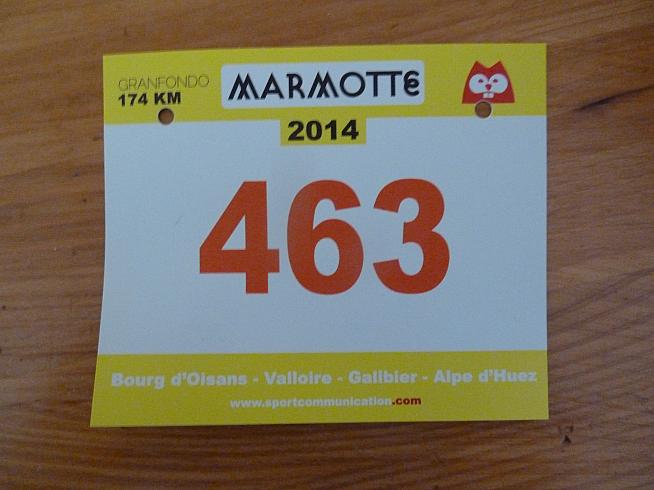
After registration we had a small wander around the stands outside the Palais du Sport. Dan bought himself a new extra large bidon and I chatted to the owner of More Than 21 Bends, one of the better regarded travel companies that caters to Marmotte riders. There was also plenty of Marmotte-branded jerseys, T-shirts and even stuffed toys, so I decided to get a couple of T-shirts as presents for my children.
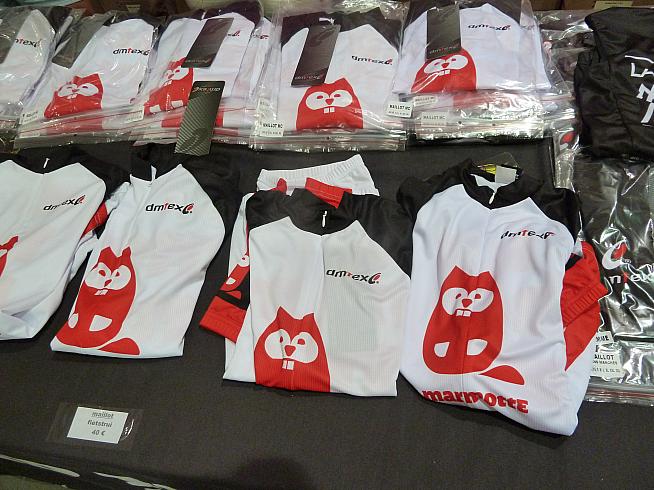
Thursday evening was relaxed. I cooked a mushroom risotto and a tomato salad and we sensibly stuck to a single bottle of red between us.
On Friday we mostly did what we meant to. Which was nothing. I worked in the morning while Dan went for another exploration of the village. Friday is market day in Alpe d'Huez so we went out and bought provisions for the evening - a courgette and fresh pea risotto (since reading Chris Froome's The Climb I've realised that pasta seems to be off the pro riders' menus and rice is much more digestible, so have switched my staple carb loading plan and halved Barilla's profits) - as well as some presents to take back to the family (wine and cheese).
We ate pizza again for lunch and in the afternoon I went for a quick spin down to bend 4 and then up to the finish line just to keep my legs interested, while Dan opted for the feet up, book reading strategy. We checked our bikes, put our timing chips and race numbers on, got our kit out and generally fussed. And we checked the weather forecast every 90 minutes, which was looking surprisingly promising given that earlier in the week we were being promised snow on top of the Galibier.
I wrote a pre-Marmotte checklist to myself for the website and tried to find a Zen-like calm, wholly unsuccessfully. One of my pieces of advice to myself was to make a race plan but truthfully I had no idea what that plan should be. I was telling friends that my aim was just to finish. A very generous friend had offered to sponsor me (for the charity I rode for when I did the 2011 Etape) and asked what time I hoped to finish in. He ended up offering £350 for under 12 hours and £250 if I finished). What did I really think I could finish in? On my Wednesday training rides one of the cyclists who knows best how good/bad I am had suggested it would be close to impossible for me to finish in over 11 hours unless I either had a terrible mechanical or physically gave up. I really had no clue what time was realistic. On top of this I had my mother and wife both telling me that there was no shame in not completing and that it would be stupid to over-reach myself; if I ever felt I was on the edge then climb into the broom wagon rather than push myself over...
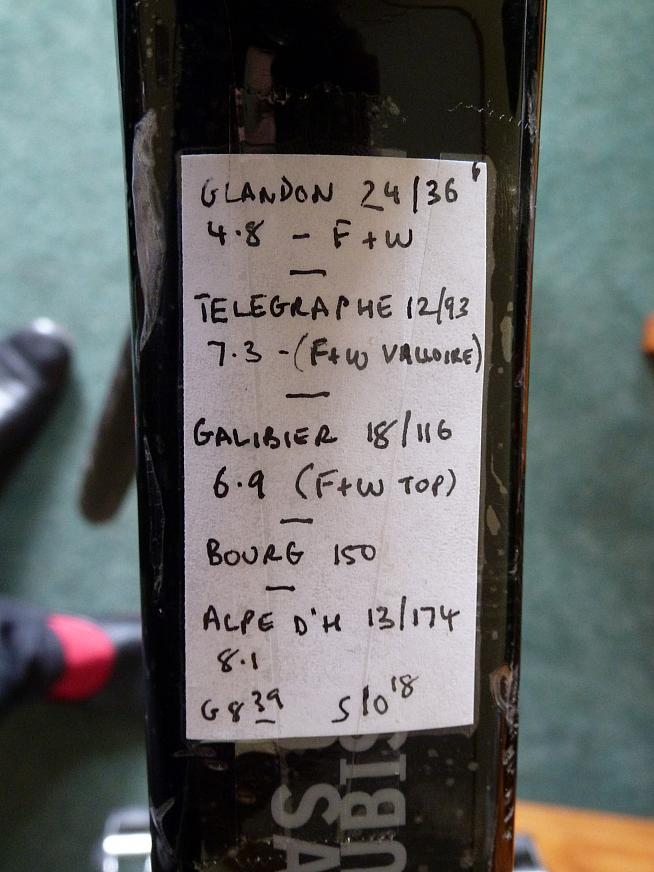
Risotto in the evening and no wine and both of us were showing distinct signs of nerves when we turned in at 9.30pm. Outside a thunderstorm delivered a lot of rain and made us reconsider whether we wanted to take a few more layers.
Race day
The day started at 5am. Actually I woke up at 4.30. And 2. And 12.30. However much you tell yourself to calm down and that the best thing you can do is sleep, it's hard actually to do that. It doesn't help that my bunk bed was probably the least comfortable bed I have slept in for the past 10 years, with the exception of sharing a tent with my children in my parents in law's garden last summer, when I might as well have not even tried to sleep. I don't think Dan slept much better. Perhaps we should have had a couple of glasses of wine to knock ourselves out.
Outside the ground was wet but the overnight rain had stopped. We checked a few different weather forecasts which suggested that conditions were about as perfect as we could wish for - about 12 degrees in Bourg d'Oisans for the start, a forecast 13 degrees at the top of the Glandon, 18 degrees in the valley to the base of the Telegraphe and then somewhere between 16 degrees and 8 degrees on that climb and to the top of Galibier. Then high 20s in the run back down to Bourg d'Oisans with temperatures on Alpe d'Huez around 25 degrees at the bottom and 16 degrees at the top.
On the basis of the forecast I decided to ride with a merino base layer, the Rapha Pantani lightweight jersey and normal (ie non lightweight) bib shorts, and to take arm warmers and a rain jacket but no leg warmers. With my pink and black helmet and pink socks I was what my children would call 'matching' (not necessarily a compliment) and I suspect other cyclists described me in less flattering terms.
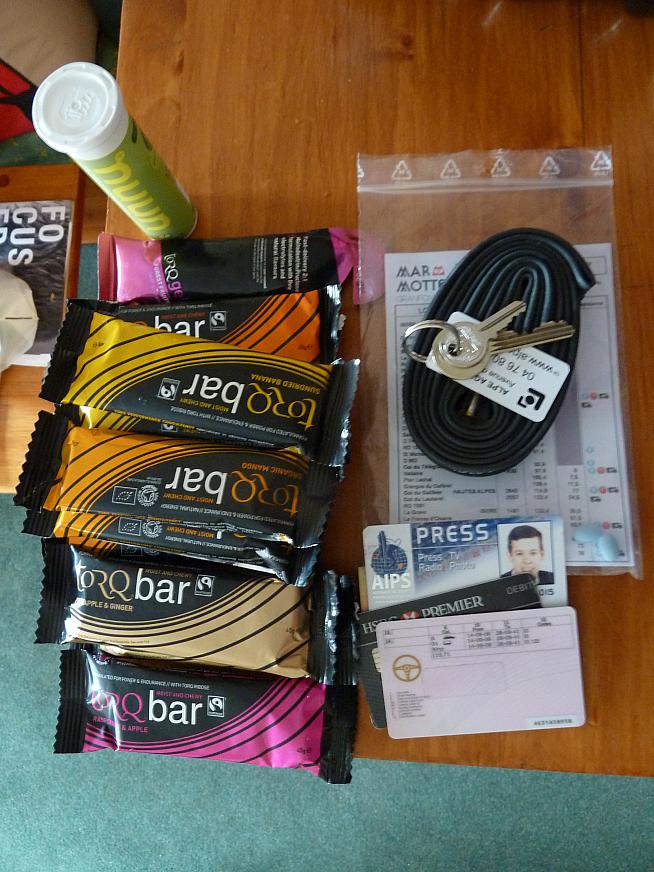
Breakfast was beans on toast and a glass of grapefruit juice, although I struggle to eat huge amounts at that time of the morning. Then a quick shower to warm the muscles up and it was time to descend from Alpe d'Huez to the start line in Bourg d'Oisans. But first it was time to make sure our tyres were fully pumped up (we probably should have done this the night before) and while I had no issues, Dan suddenly found his front valve disintegrating and having to do a completely change of inner tube. While the clock ticked by I reassured him we had plenty of time and it was only 5.55am, when in fact it was more like ten minutes later.
The descent to Bourg was fun. I spent most of the time talking to someone British who was riding the Marmotte for the fifth time and the fastest he had completed it in was eleven and a half hours. He had some good words of advice about the Glandon, which I had never ridden before (mainly about not getting caught out on gearing when coming out of the descents as the steepest part of the climb is immediately after the descents). It was amazing to watch so many people descending so early in the morning and also the number of people who were puncturing, perhaps from over use of their brakes (if you sit on the brakes too much it heats up the wheel rims and then the inner tube can burst from overheating) or perhaps just from bad luck. There were some crazy motorists also descending at the same time - many of them with elite starting numbers - and it did slightly cross my mind that someone British had been killed on the descent just six days earlier.
In Bourg we followed the signs to the starting pens which seems to take us on a massive loop around the suburbs before arriving in one of the main streets in our starting pen at 6.45am, which was for riders from number 400 to 2000. Apart from the entire population of Copenhagen, there seemed to be a decent mixture of rider types. I had expected everyone to be stick thin, have diamond shaped calves and shaven legs but it seems that quite a few 'normal' people had been placed in earlier pens (I later found out that the top travel companies have allocations in the earlier pens) and there were even some other people adopting the Captain Caveman leg-style.
Dan and I chatted nervously for 15 minutes, remarking on the lack of Rapha-clad cyclists and being surprised at how so many people seemed to be stuck in the 1980s look of team kit with every conceivable part of their clothing covered in corporate logo. We spotted a lot of expensive bikes but I was looking around for another Condor and it became my challenge to see how many I could spot during the day.
For those of a practical mind, the main problem at the start was the lack of loos. If you want to relieve yourself prior to the start, I suggest you do so before you hit the starting pens. There were a couple of portable toilets (I did type Portaloo but I've found in the past that means that I get an angry email from the Portaloo corporate legal department pointing out that it is a trade name and not a generic description, a bit like saying Hoover or a Bic rather than a vacuum cleaner or a ballpoint pen) but there were long queues and they didn't look especially inviting.
We started rolling at just after 7am. I shook hands with Dan to wish him the best of luck and we crossed the start timing mat at 7.08 am.
I had promised myself I would not go too quickly in first 12km run to the base of the Glandon. Of course five minutes after the start I looked down to see I was going 56km/h and I was still one of the slowest people on the road. I tucked into a peloton and hoped for the best, not daring to look behind me to see if Dan was in my slipstream (he wasn't, as you can read about in his Marmotte ride report).
I was surprised at how many people were puncturing and having mechanicals. Every couple of hundred metres there was someone stopped at the side of the road either replacing an inner tube or looking distressed. Obviously with 7,500 people starting the Marmotte and a total of 1.3 million kilometres being covered by riders during the day you'd expect a lot of trouble but it did seem surprising just how many people were suffering and possibly hadn't done a full inspection of their bike before starting.
Along the road the fastest cyclists kept to the left - I was riding right down the middle of the road - and this created some interesting dynamics as there were still people making their way to the start line coming in the opposite direction. With the roads into Bourg being closed very early in the morning - around 5.45 I think - quite a lot of people who had been staying towards Grenoble had been unable to drive to Bourg d'Oisans for the start and had to park down the valley and cycle to the start line, which meant they were going against the flow. It looked dangerous to me and although I didn't see any crashes there were a couple of near misses as groups of riders going around 65km/h came down the left side of the road towards less experienced riders coming in the 'wrong' direction on supposedly closed roads.
About 12km into the ride the day's climbing begins. I caught up with a man wearing the same Pantani jersey as me and said 'nice jersey' and he laughed and in a thick French accent said "I don't think I can live up to it", which we both agreed with. It is hard to say where the Glandon climb officially begins (perhaps there is a sign that I missed) but I settled into a good rhythm and enjoyed the shade of the trees on the way up along with the fact that it was early enough in the day that it wasn't too warm. It would be fair to say that I was being overtaken a great deal more than I was overtaking. I stuck to the right of the road as a succession of speedy riders overtook, no doubt laughing that number 463 was so easily caught. I did overtake a few riders though, although being faster than a one legged man is not a great achievement. Chapeau to that guy...if he completed (and I have every reason to believe he would have given the look of determination on his face) then it puts pretty much every other rider's pain into perspective.
At the top of the Glandon there were plenty of support tents for riders in organised tours. At the summit there is a timing mat that stops your time when you ride over it, only restarting when you cross a second timing mat at the bottom of the mountain. The reason for this is that the descent is what riders call 'technical' (in other words, steep and with lots of tight bends and big drops to fall off if you get it wrong) and a few people have died going down it on previous Marmottes. The organisers now exclude the time for the descent to stop people taking crazy risks. I would have been pretty peeved if the tour I was on had a tent on the wrong side of the timing mat, meaning that you were still losing time as you picked up your provisions. Anyway, I was riding unsupported and as I was feeling pretty good and it was a scrum at the top, I decided to press on and not stop at the top of the Glandon, having got there in 2 hours and 2 minutes. This may have been a mistake.
The descent off the Glandon may have been neutralised but it was still pretty quick. I didn't push hard and there were lots of people overtaking me; hopefully I didn't steal their racing line and there was no-one swearing at me and generally speaking no one got too close to me. Although I had pulled up my arm warmers (which had been pulled down on the ascent) I hadn't put on my rain jacket but my temperature was fine. My left hand hurt from gripping the brake levers and my lower back started to ache from an old injury from 20 years ago and I started to get a little worried about how I was going to survive another 100km of this. On top of this my right foot was a little painful, although that seemed to be fairly easily solved by loosening the straps on my shoe.
At the village at the bottom I stopped to offload some extra liquid (the organisers could probably do with putting some open air urinals up as the villagers must get somewhat irritated by so many people peeing behind their bins) and eat a fruit bar and searched in vain for a water station, which I had been told would be somewhere nearby. Up to this point I had only drunk only one bidon (one litre) after two hours forty minutes of riding, which I think was probably not nearly enough. I had consumed three fruit bars in total, which was on target, but because it was relatively cool I hadn't thought enough about hydration.
After crossing the timing mat to restart my official time, I set off on my own towards the base of the Telegraphe. I had been told by previous participants to get in a group along the valley to Saint-Michel-de-Maurienne but there was no one around. For the first 2km I just went along on my own at 34km/h and passed just one person, someone from the starting group who I guess was 70 years old and may easily have won the Marmotte 45 years ago.
Two kilometres in I was passed by a group of about 40 riders, led by a Saxo Tinkoff team-clad group of four. They were keeping up a ferocious pace but I managed to latch on to the rear for about 8km and then the elastic snapped. I couldn't keep up. I eased off a touch to wait for the next group to come past and after 2km no one had caught up. At that point I looked behind me and found I was leading a peloton of about 140 riders, which was certainly not my intention. I gestured to the riders behind me to take a turn at the front but none of them seemed keen so I dropped my pace and after a couple of minutes someone obviously snapped and decided to overtake, at which point I let about 50 people surge past before drifting into the pace line and allowing myself to be dragged along to the base of the Telegraphe.
By this point I was getting somewhat concerned by my lack of water. I still had over half a bidon left but I had been deliberately conserving water and not drinking as freely as I normally would. I didn't feel thirsty but everyone says that when you feel your mouth is dry that it is already too late. Thank goodness on the approach to Saint-Michel-de-Maurienne there was a sign saying 1km to a water stop. I watched carefully over the next 1000 metres but there was no indication where to turn off and when we passed what I think was the water stop (I am still not certain there was one) it was too late. Now I did start to worry. The next stop I definitely knew was available was at the top of the Telegraphe, which while it is only 12km away is all uphill.
Turning off at St-M-de-M, the route suddenly became familiar for the first time. From here onwards this was the route I had ridden in the 2011 Marmotte. Idiotically I passed people filling their bidons from a public fountain/water tap on the outskirts of the village. I look back now, a week later as I write this report, and ask why I didn't simply stop there and fill up. But I felt good, the top of the Telegraphe wasn't that far off (12km) and what could go wrong?
The road up the Telegraphe is a fantastic climb. That's not to say it isn't steep but it is steady and doesn't have a lot of surprises. It also had plenty of shade, which reduces your chances of overheating. Because it is the climb before the Galibier it doesn't really get the attention it deserves...a bit like Canada sitting next to USA or Belgium next to France, I suspect the Telegraphe has an inferiority complex (if mountains could have such thing, which obviously they can't). This year the French road maintenance teams decided to spice the ride up by removing the top layer of the road for roughly 5km of the climb, ahead of resurfacing. That means that it should be a lovely ascent for the 2015 Marmotte but for those riding in 2014 it was distinctly sketchy.
Somewhere up (I think about 4km in) the climb there was a water station. Thank goodness! Not on the Marmotte schedule but so much needed by me. My anxiety disappeared immediately and I could down the rest of my bidon and fill up for the rest of the climb. It is only when you can drink freely that you realise how thirsty you are. I also ate another fruit bar.
I reached the top of the Telegraphe and one of the scheduled feed stations but decided to press on to the stop in Valloire, a short downhill from top of Telegraphe. Actually the feed station is 2km out of Valloire, all uphill, and there were a lot of grumpy riders alongside me asking where the promised stopping point was. I reached the Valloire food point in 4 hours and 50 minutes.
Looking back I can pretty much identify my ride as pre-Valloire and post-Valloire. For my age group (40-49) the gold time in 2014 is 8 hours 39 minutes and up to that point I was setting a time that could - if I kept up the pace - get me a gold medal time. However I could tell that there was absolutely no way I could keep up the same pace for the second half of the Marmotte. I knew the silver cut off time was 10 hours and 15 minutes, which meant I would have to be ridiculously slow to finish outside that time. So I decided I could afford to ease off slightly and not put myself in any serious pain for the second half of the day.
At Valloire I ate some dried apricots, a banana and some baguette over the course of a ten minute stop and then decided to press on. By now the sun was fully out and the temperature was in the mid 20s, which was very pleasant. The run to Plan Lachat, where the climb of the Galibier starts in earnest, is fairly pretty and the views of the moonscape like rock surfaces were a good distraction from the large number of cyclists going past me at considerably faster speeds than I was managing.
By Plan Lachat I was feeling fairly tired, perhaps the result of not having eaten or drunk enough earlier in the ride. A rest was needed so I pulled up at Plan Lachat, bought a can of Coke (2.40 euros) and sat under the shade of an umbrella for five minutes. A couple of other riders spotted me and decided to do the same, both remarking that I looked so happy sipping my Coke that they decided to copy me.
The Coke did the trick and I was soon back on the bike for the slog up the Galibier. This was the third time I have done the climb and I have always been lucky to do it in good conditions. With a headwind or in the cold and rain it must be grim but I have so far found it to be quite an enjoyable ascent. With photographers on the roadside and a few family friends of other riders cheering us on it was it even quite fun, although the piles of snow beside the road were a good warning that just two weeks earlier it had a five centimetre covering of snow on the top.
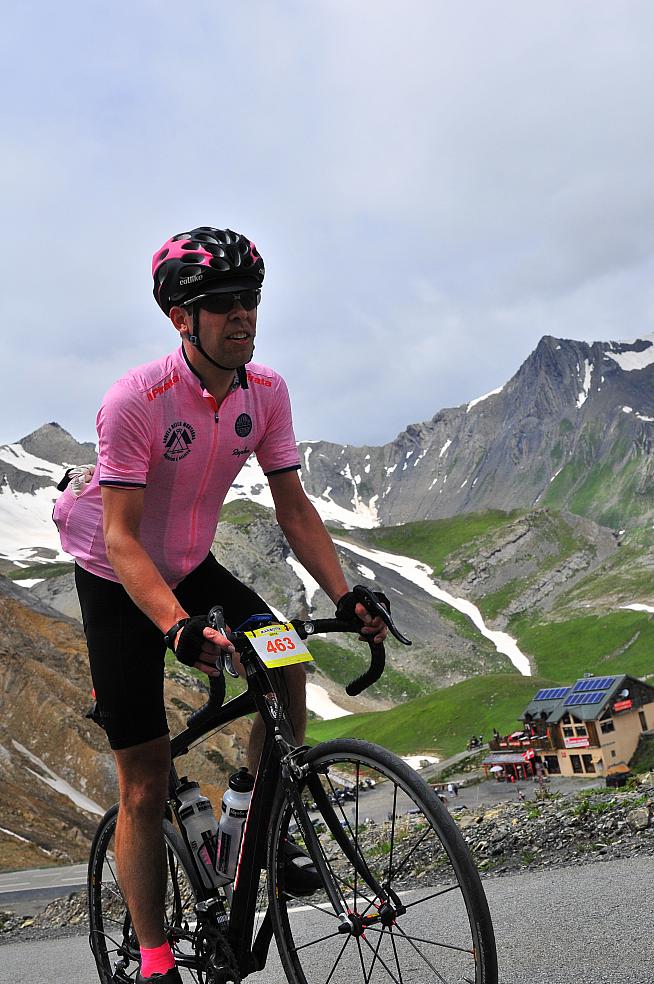
At the top I definitely needed to eat and top up the water. Bananas and dried apricots from the army tent were swiftly downed as I also tried to work out what to wear on the descent. In the end I settled for arm warmers and my rain jacket, although some people not putting anything on and I worried that I might be too hot.
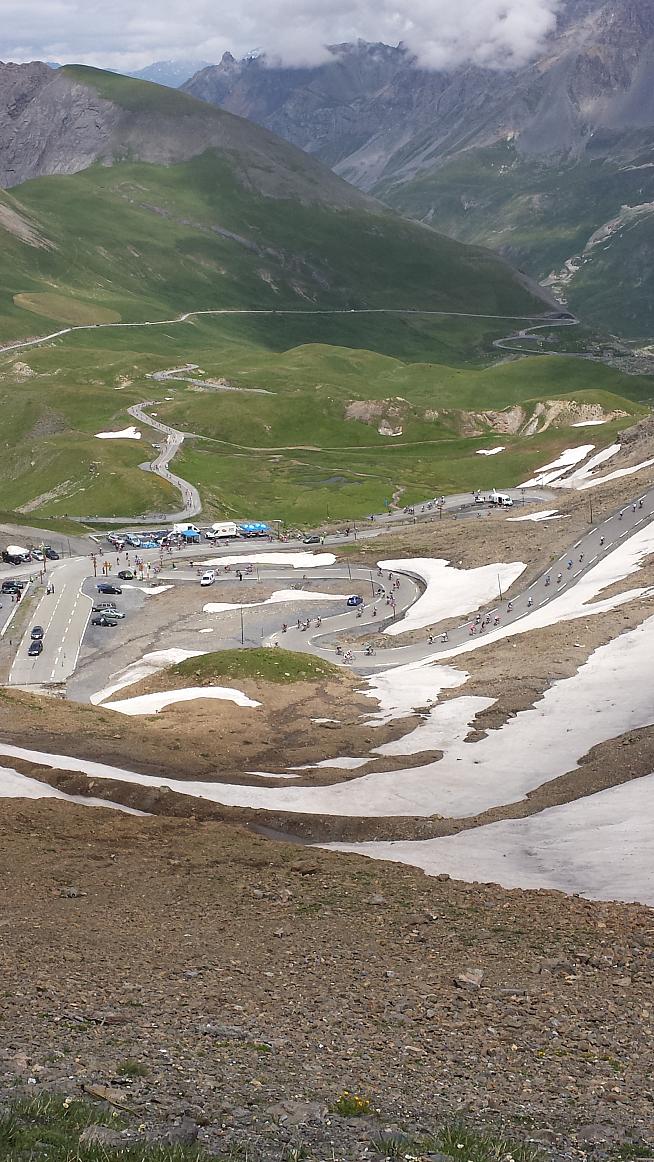
The descent was fast, cold and involved a lot of people overtaking me, despite my hitting a top speed of 67.7 km/h. I guess some people were comfortably in the 90s. There were no cars coming up but there were lots of signs warning to stay on right and I wasn't totally sure that the route had been closed to traffic so I didn't want to take any silly risks. How anyone descended the Galibier without arm warmers I do not know - I definitely needed both arm warmers and a jacket and I would have been happy to have a thicker jacket. Had the weather been anything other than the benign conditions we enjoyed I would have been in bad shape.
At the bottom of Galibier you turn right for road back to Bourg and although I was looking for a group to join there was nothing suitable as they kept whizzing past as speeds I couldn't maintain. This is the disadvantage of only weighing 64 kilos and riding a compact - you can't go as fast as other people downhill. Although officially the roads were closed to traffic - or at least that is what the signs had said - there were a small number of British cars on the road which kept overtaking me and then I would overtake them. They were particular useful in the tunnels as their lights let me see the potholes and gravel which normally make the tunnels so dangerous as groups of cyclists charge through them at 50km/h.
When I hit the small uphill section of the ride to Bourg I (and many others) stopped to take off my jacket and arm warmers as it was pretty warm in the valley and I attached myself to a group of about 20 riders who dragged me along to the foot of the Alpe in a time of 8.05, including the neutralised zone (so 7 hours 27 minutes without the neutral zone).
At the slightly less well stocked feed station I again ate dried apricots, a banana and a fruit bar, as well as having a brief chat with one of the early starters, aged at least 60, who had already climbed the Alpe and was back down and handing in his timing chip. He'd completed in 7 hours and 20 minutes.
And so to the Alpe. I have tackled it once before in 2011 when it was 43 degrees heat and I didn't enjoy it very much. I knew it wouldn't be much better today. It is as much a test of the mind as the body. Fortunately I had decided I would be taking it relatively easy, including promising myself a can of Coke at the cafe on bend 16. Yes, I know that's not what you are meant to do. But I knew I'd be cooked if I didn't have a stop and Coca Cola seems to have the magic formula to keep me going.
On bend 19 (you count down from 21 at the bottom to bend 1 at the top) I looked down to see it was 36 degrees. With the promise of a Coke coming soon, I started passing people for first time. The cafe soon appeared and the waitress looked rather surprised at my laziness. As I checked my emails for the afternoon UK horseracing results I did some mental calculations about how quickly I could finish and realised it was just about plausible to complete in under nine and a half hours. It was just what I needed to keep me going...a target that was achievable but only just.
I don't remember every detail of my climb. I do remember stopping at one point to douse myself in the water from an Alpine stream and also tipping a cup of water over my head to try and cool down. I am not brilliant in the heat and was definitely suffering, although not nearly as much as quite a lot of people around me.
From bend 8 I decided needed to keep going without stopping and with 4km to go I had 23 minutes to get in under nine and a half hours. Given I was doing a ridiculously slow 8.3 km/h this was looking close. I knew the final 500 metres was flat as I had ridden it the day before. My spirits were raised on the edge of town by strangers cheering riders on and ringing cow bells and I sprinted the last 500 metres to arrive with just over two minutes to spare of my self imposed time limit.
My final official time was 9:27:42.01, which meant I was 4,133rd of the roughly 7,500 starters and good enough to qualify for a silver medal. Once I had worked out that the queue for the certificates was about 45 minutes long, I decided a shower was much needed and headed back home to wash and ring my wife and my parents to reassure them that I was still alive.
Clean and back in civilian clothes, I headed to the O Bar to rehydrate with beer and wait for Dan to come past. He'd been texting me with updates so I knew he was starting to climb the Alpe just as I had finished. I chatted with the people around me, cheered on hundreds of people as they rode past and when Dan finally arrived whipped up the crowd to cheer him on before running to meet him at the finish line. Exhausted and exhilarated from his ride, Dan was keen on a quick beer to refresh himself before going back to the flat while I picked up our certificates, medals and returned the timing chips (it turns out you swap your timing chip for a medal, which means they effectively cost 10 euros per medal).
Dan joined me at the O Bar at 9.15pm, almost exactly at the same time as the broom wagon was pulling into Alpe d'Huez, trailing the last categorised rider, Torben Larsen, who finished in an official time of 13 hours and 25 minutes (he does have the good excuse of being in the 67+ age category). After a beer we decided to go and look for food, only to find that every restaurant was fully booked, which perhaps was not entirely surprising. So we staggered home to eat reheated risotto, quickly drink a bottle of wine and then collapse into bed.
Conclusion
The Marmotte is a fantastic event. Sport Communication do a really good job organising it, providing support, feed stations and closing a good proportion of the roads. If you want a proper challenge the Marmotte is definitely up there with the most difficult sportives in the world.
I'll definitely be back to ride another Marmotte, although probably not for a couple of years. When I do go back I need to remember the following:
- Do some proper long rides before the Marmotte. The longest ride I did before the Marmotte was 155km, which given how much climbing there is in the Marmotte was not long enough. I was really flagging at the end (it took me an hour and 50 minutes to climb the Alpe, including my Coke stop) and a lot of this was down to a lack of long distance fitness.
- Learn how to eat and drink. This many sound silly but I really struggle to eat enough on long rides. There came a point where I could not face enough fruit bar or banana. Eating a baguette at the Valloire food stop was unpleasant. I need to work out a proper feeding strategy and bring food I like, preferably energy packed but not too sweet. Then I need to be completely disciplined and actually force myself to eat. I returned from the Marmotte with five uneaten Torq bars, which suggests I either took far too many in the first place (I took ten) or I ate probably three fewer than I should have.
- Stay in a bigger flat. It was a false economy staying in such a tiny flat as the bed was too small and uncomfortable to rest properly before the race and then I had a terrible night's sleep after the Marmotte, which meant I was exhausted for the drive back to London. Spending a little bit more would have been a wise idea.
Could I record a gold medal time? Possibly, although I was 48 minutes off hitting it this time. Obviously I could have stopped for less time - I was at feed stations for an estimated 35 minutes in total plus I stopped for two Cokes. If Alpe d'Huez hadn't been so hot I would have been in much better shape; had it been raining I would have definitely got up it faster. I'd like to think it would be much closer next time but getting gold would be pretty tough. I think it's worth finding out.
0 Comments





